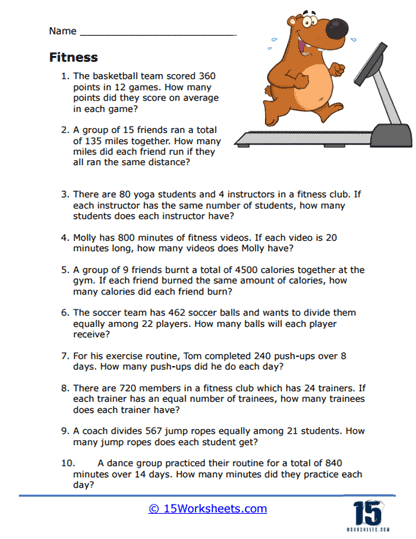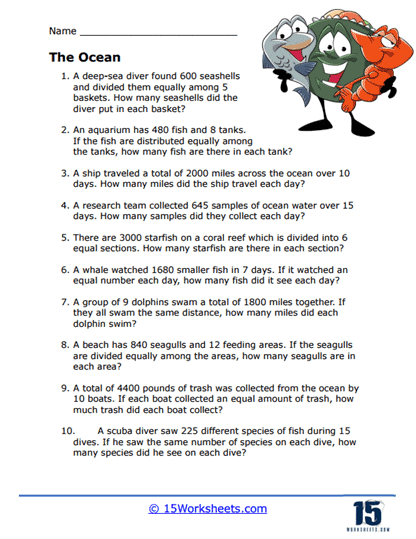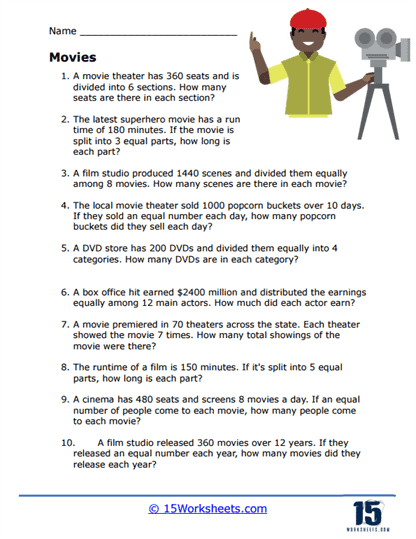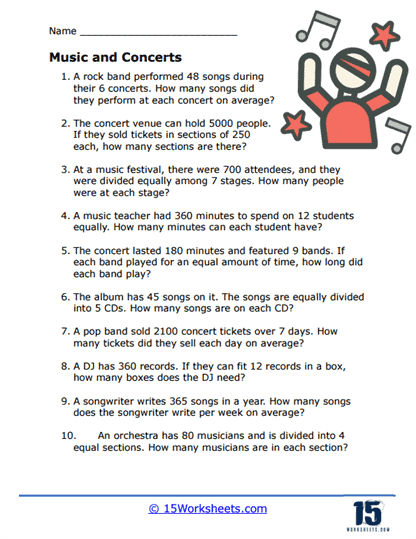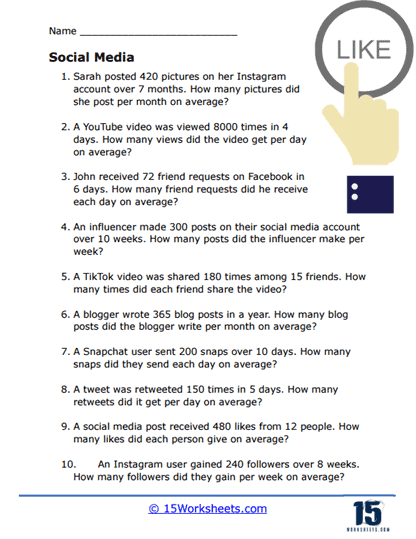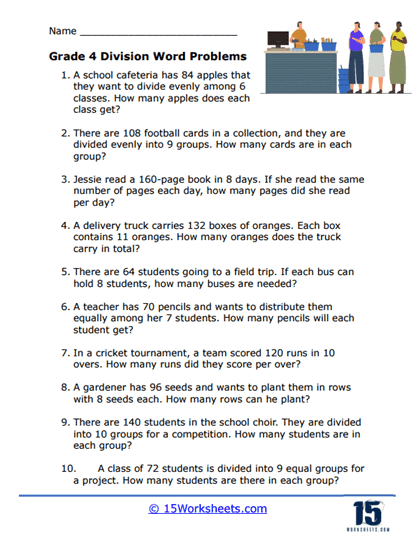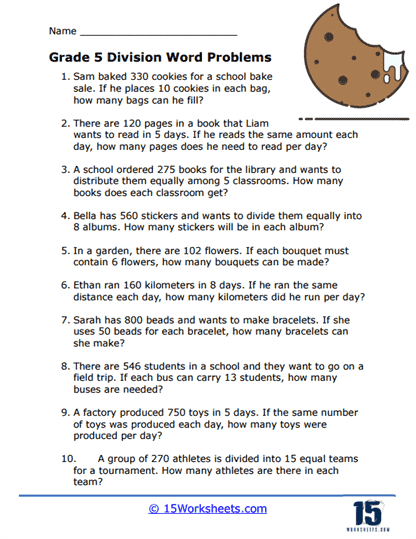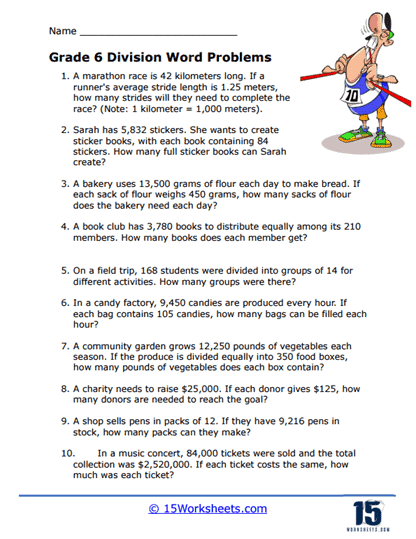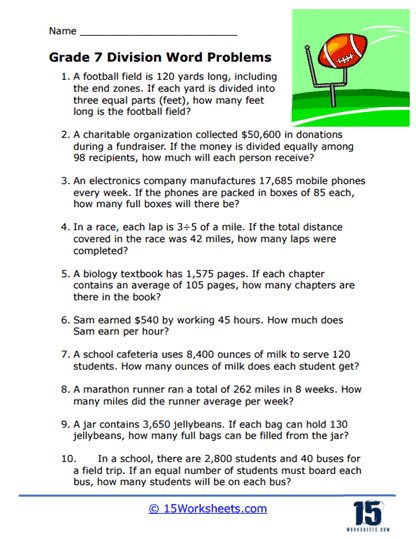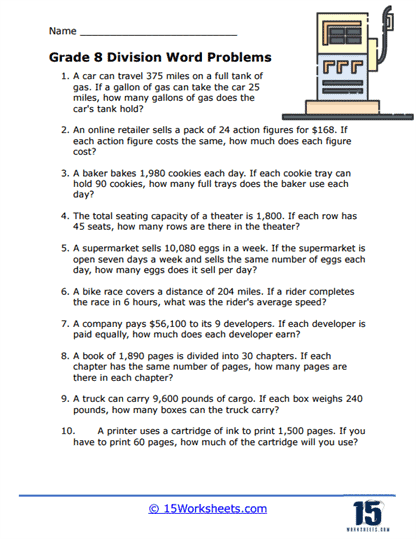Division Word Problems Worksheets
About These 15 Worksheets
Our division word problem worksheets were designed to help students practice and improve their division skills by solving real-life problems that require dividing numbers. These worksheets present scenarios where quantities need to be divided into equal groups or distributed among individuals or objects. Division word problems are an essential component of mathematics education, as they allow students to apply division concepts to practical situations, fostering a deeper understanding of mathematical operations.
These worksheets are structured to challenge students to read and interpret written information, identify relevant numbers that need to be divided, and perform division calculations accurately. The problems can cover various aspects of division, such as basic division, long division, remainders, fractions, and even more complex concepts like ratios and proportions. By solving these problems, students not only develop their computational skills but also enhance their problem-solving abilities, critical thinking, and logical reasoning.
Division word problems can involve a wide range of topics and complexity levels. They may require students to find the number of items in each group, determine the total number of groups, calculate shares or portions, or even solve real-world scenarios involving budgeting, distribution, or sharing resources. These problems encourage students to use division as a tool for practical decision-making and problem-solving, making math more relevant and engaging.
Educators often incorporate division word problem worksheets into their teaching materials to assess students’ proficiency in division and their ability to apply division principles to real-world contexts. These worksheets can be tailored to different grade levels, ensuring that students progress from basic division skills to more advanced applications as they advance in their mathematical education.
A Look At The Individual Worksheets
In the realm of fantasy and fun, worksheets like “Monster Word Problems” and “Gift Giving Division” invite students to tackle division challenges involving mythical creatures and festive scenarios. These exercises not only make math entertaining but also help students understand the practical applications of division in everyday situations.
For those with a penchant for pop culture and modern life, worksheets such as “Movie Word Problems,” “Music and Concerts Math,” and “Social Media Division Word Problems” integrate familiar contexts into mathematical problems. By calculating ticket sales, streaming statistics, or social media metrics, students see firsthand how division plays a role in the entertainment industry and digital world.
Real-life applications are further explored in worksheets like “Fitness Word Problems,” “The Ocean,” “Country Word Problems,” and “Car Word Problems.” These tasks challenge students to apply division in scenarios ranging from environmental studies to automotive calculations, reinforcing the subject’s relevance beyond the classroom.
To cater to varying skill levels, the collection includes grade-specific worksheets from Grade 3 to Grade 8. Each set is tailored to the appropriate complexity, ensuring that students build a strong foundation before progressing to more challenging problems. This structured approach supports continuous learning and confidence in mathematical abilities.
What Are Division Word Problems?
Division word problems are mathematical problems that involve the operation of division. They require you to use critical thinking and problem-solving skills to interpret and solve a situation or problem described in words, where the solution involves division.
Let’s look at an example:
Rachel has 36 cookies. She wants to distribute these cookies equally among her 6 friends. How many cookies will each friend receive?
:To solve this problem, we have to divide the total number of cookies by the number of friends.
So, the operation we’ll perform is 36 ÷ 6.
When we perform this operation, we find that each friend will receive 6 cookies.
That’s the basic idea of a division word problem. It presents a situation where you must divide a quantity into equal parts. The problems can get more complex as you increase the grade level, but the concept remains the same. These problems are often used in school to teach division and improve problem-solving skills.
Examples of Decimal Word Problems
Problem 1 (Easy): Anna has 18 candies, and she wants to share them equally among her 6 friends. How many candies will each friend receive?
Solution: To find out how many candies each friend will receive, divide the total number of candies (18) by the number of friends (6):
Number of candies per friend = 18 / 6
Number of candies per friend = 3
Each friend will receive 3 candies.
Problem 2 (Intermediate): A bakery baked 120 cupcakes for a party. If each cupcake is to be placed on a tray with 8 cupcakes in each row, how many trays will they need to display all the cupcakes, and how many cupcakes will be left over?
Solution: First, find out how many cupcakes can fit in one tray:
Number of cupcakes in one tray = 8
Now, to determine the number of trays needed, divide the total number of cupcakes (120) by the number of cupcakes in one tray:
Number of trays = 120 / 8
Number of trays = 15
So, they will need 15 trays to display all the cupcakes.
To find the number of cupcakes left over, subtract the total number of cupcakes placed on trays (15 trays * 8 cupcakes/tray) from the initial total:
Cupcakes left over = 120 – (15 x 8)
Cupcakes left over = 120 – 120
Cupcakes left over = 0
There will be no cupcakes left over as they have used all 120 cupcakes to fill the 15 trays.
How to Know When a Word Problem Calls for Division
Identifying whether a word problem calls for division is a matter of interpreting the language and understanding the situation presented in the problem. There are some key words and phrases that typically indicate a division operation is needed. Here are some cues:
Shared equally – When a total amount is being distributed or divided into equal parts.
Example – Sam has 24 apples. He wants to share them equally among his 6 friends. How many apples will each friend get?
Per – The word “per” is often a clue that division is needed, especially when we’re talking about rates or ratios.
Example – If a car travels 300 miles on 10 gallons of gas, how many miles does it travel per gallon?
Each – When something is being divided evenly into groups, the word “each” is often used.
Example – Jessica has 56 stickers. She puts them in 8 equal piles. How many stickers are in each pile?
Average or Mean – If a problem asks for the average, it’s a division problem.
Example – What is the average of the following five numbers – 5, 10, 15, 20, and 25?
How many times – When a problem asks you to figure out how many times one number fits into another, it’s asking for division.
Example – How many times can 5 be subtracted from 20?
Remember, these are just indicators, not guarantees. Some problems might use these words but require other operations too, and some problems might require division without using these words. Always consider the overall context and what the problem is asking you to find.
When We Use This Skill In the Real World
Cooking and Baking – If you’re cooking or baking and need to adjust a recipe, you’ll often need to use division. For instance, if a recipe serves 8 but you only want to cook for 2, you’ll need to divide the quantity of each ingredient by 4.
Budgeting and Finance – If you’re managing a budget, you might need to divide your total funds by the number of weeks in the month to work out how much you can spend each week. Similarly, if you’re calculating per-person costs for a group trip, you’ll divide total expenses by the number of people.
Workplace Scenarios – Many professions use division regularly. For instance, teachers dividing class time among lessons, nurses dividing medicine doses, builders dividing materials for construction, or business professionals analyzing performance data.
Travel – If you’re planning a road trip and know the total distance and your car’s miles-per-gallon rating, you can divide to figure out how much gas you’ll need.
Events planning – If you’re planning an event and you need to distribute items equally among guests or figure out seating arrangements, you might need to use division.
Environmental conservation – For instance, to calculate the average amount of waste produced per person in a city, you would divide the total waste by the population.



